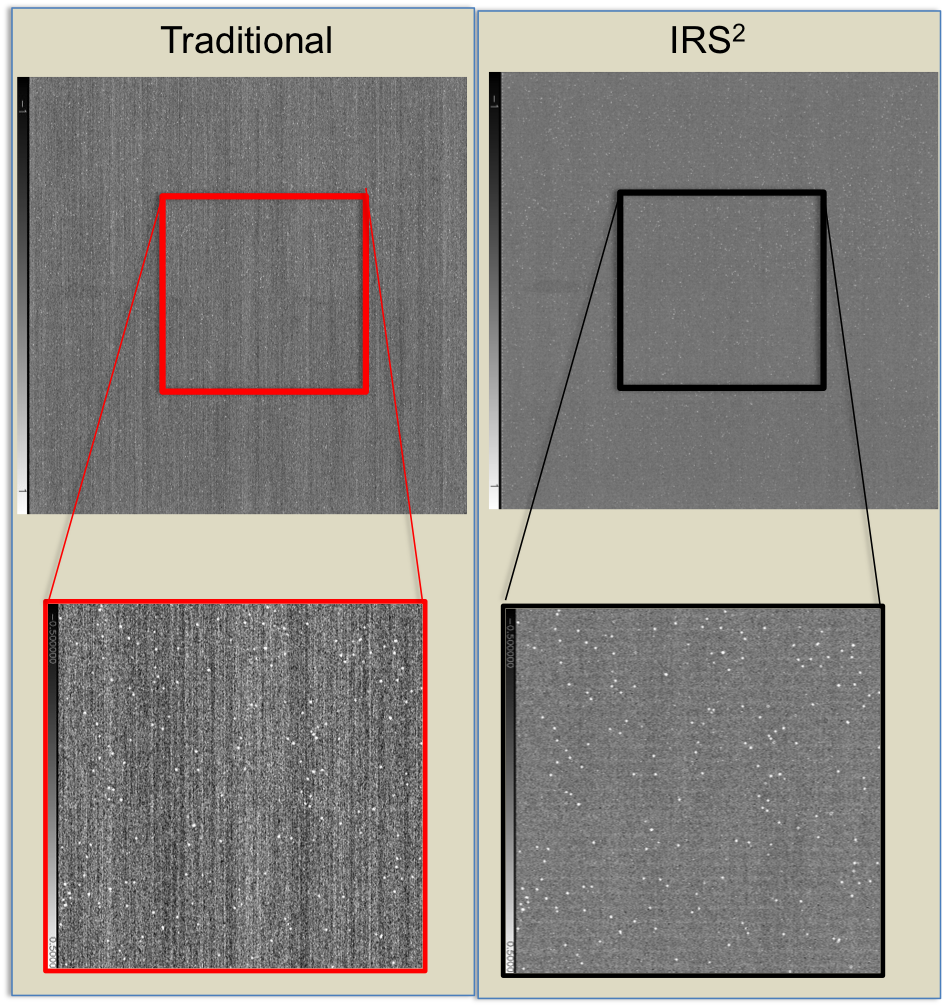NIRSpec Detector Readout Modes and Patterns
On this page
NIRSpec supports 2 readout patterns in each of its 2 readout modes: traditional and improved reference sampling and subtraction (IRS2). The traditional detector readout mode is the same one that is used by the JWST NIRCam and NIRISS instruments. However, ground test characterization of the NIRSpec detectors showed that the traditional readout did not meet the more stringent noise requirements for NIR spectroscopy of faint targets (<6 e– total noise, measured over ~1000 s long dark exposures).
As a result, a more sophisticated readout method was devised by the NASA Goddard detector characterization team, called improved reference sampling and subtraction (IRS2, Rauscher et al. 2012). This IRS2 readout mode has a much improved correlated noise performance, and is particularly beneficial for long observations of faint targets. For both the traditional and IRS2 readouts modes, 2 readout pattern options are offered which allow users to either save all individual frames, or to save the averaged groups of frames, as described in the NIRSpec Detector Readout article.
This page includes:
- A comparison of NIRSpec traditional vs. IRS2 readouts
- Traditional vs. IRS2 detector readout performance
For more detailed information, see these associated articles:
A comparison of NIRSpec traditional vs. IRS2 readouts
Figure 1 presents data characteristics of the traditional and IRS2 NIRSpec detector readout modes. Table 1 summarizes the readout patterns available in each of these modes and some key properties. Note that the IRS2 readout cannot be used with subarrays. The best choice of readout pattern should be made using the NIRSpec Detector Recommended Strategies article, and checking the ETC with specific target brightness and noise properties.
Use of the IRS2 detector readout pattern options are recommended for all full frame NIRSpec integrations that are not in danger of saturating the detector.
Table 1. Available NIRSpec detector readout patterns
Detector readout mode | NIRSpec readout pattern name | Nframes per group | Group time (s) | Unprocessed data size (one integration) |
| Traditional | NRSRAPID | 1 | 10.737 | 2048 pixels × 2048 pixels x Ngroups |
| NRSRAPIDD1 †,‡ | 1 | 21.474 | ||
| NRSRAPIDD2 †,* | 1 | 32.210 | ||
| NRSRAPIDD6 §,¶ | 1 | 75.159 | ||
| NRS | 4 | 42.947 | ||
NRSIRS2RAPID | 1 | 14.589 | 3200 pixels × 2048 pixels x Ngroups | |
| NRSIRS2 | 5 | 72.944 |
† NRSRAPIDD1 and NRSRAPIDD2 are used for MSATA target acquisition only.
‡ NRSRAPIDD1 reads one frame and drops one.
* NRSRAPIDD2 reads one frame and drops two.
§ NRSRAPIDD6 reads one frame and drops six.
¶ NRSRAPIDD6 is available for TA only (WATA or MSATA).
Words in bold are GUI menus/
panels or data software packages;
bold italics are buttons in GUI
tools or package parameters.
Performance of NIRSpec traditional vs. IRS2 readouts
Because of its improved noise performance, the IRS2 readout mode is recommended for all full frame NIRSpec exposures in MOS, IFU, and FS observing modes that are not in danger of saturating the detector.
The IRS2 detector readout results in raw data that is 3200 × 2048 pixels per frame, compared to the standard 2048 × 2048 pixels in traditional readout data (Figure 1). The IRS2 readout mode includes increased sampling of reference pixels and recorded reference output information, and is described in more detail on the IRS2 readout mode page. The main benefit of IRS2 mode is the reduction in correlated (1/f) noise which causes the "striping" which is shown clearly in Figure 2. Reducing 1/f noise is very important, especially when using distant shutters for obtaining spectra of the sky background. Table 2 presents the noise characteristics for the two NIRSpec detectors using traditional vs. IRS2 readout. The total noise is slightly improved in IRS2 mode (for the whole focal plane array) and it offers significantly reduced 1/f (or correlated) noise, as is evident from Figures 2 and 3 below.
For science observations that might saturate NIRSpec, the best choice of readout pattern should be made by following the guidelines presented in the NIRSpec Detector Recommended Strategies article and by using the ETC for specific targets. Because the frame time is longer in IRS2 mode, brighter targets may be at greater risk of saturation.
Table 2. NIRSpec NRS1 and NRS2 detector noise performance in traditional and IRS2 readout
| Parameter | Measured NRS1† | Measured NRS2† |
|---|---|---|
| total noise, traditional readout | 6.9 e¯ | 7.3 e¯ |
| total noise, IRS2 readout | 5.9 e¯ | 7.2 e¯ |
† These values are for ~950 s integrations as measured on-orbit during commissioning and include the effects of cosmic rays after mitigation.
References
Rauscher, B., et al. 2012 SPIE 8543
Reducing the read noise of HAWAII-2RG detector systems with improved reference sampling and subtraction (IRS2)


